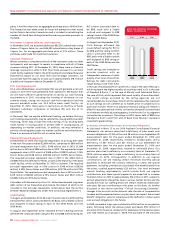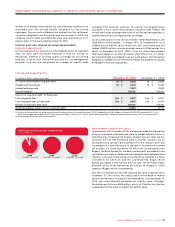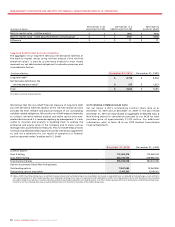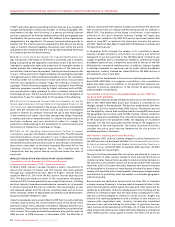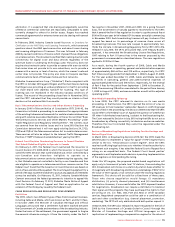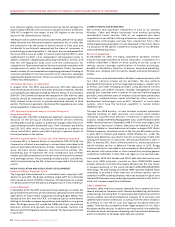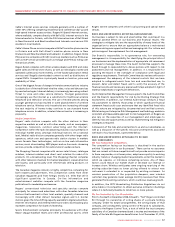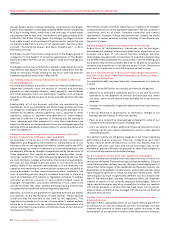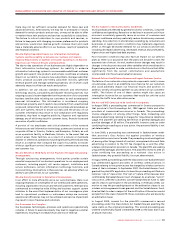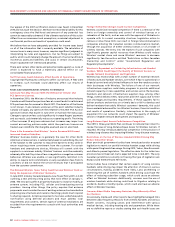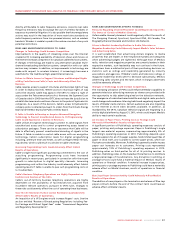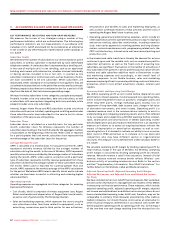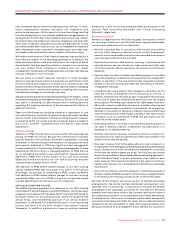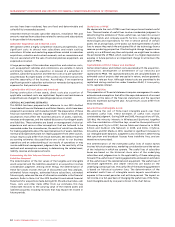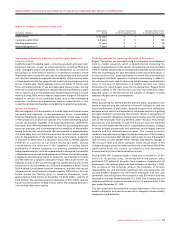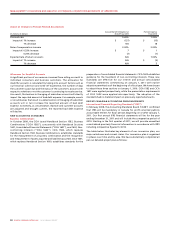Rogers 2010 Annual Report Download - page 52
Download and view the complete annual report
Please find page 52 of the 2010 Rogers annual report below. You can navigate through the pages in the report by either clicking on the pages listed below, or by using the keyword search tool below to find specific information within the annual report.
MANAGEMENT’S DISCUSSION AND ANALYSIS OF FINANCIAL CONDITION AND RESULTS OF OPERATIONS
56 ROGERS COMMUNICATIONS INC. 2010 ANNUAL REPORT
local television signals, more commonly known as fee-for-carriage. The
report simply referred to the conclusions and policy laid out in Decision
2010-167 in regard to the impact of any VFS regime on the various
sectors of the communications industry.
The Report did recommend that the Government amend the Canadian
Radio-television and Telecommunications Commission Act to clarify that
the Commission has the power to award interim or final costs and
incidentals to participants representing the views of consumers in
broadcasting proceedings before it. The report also recommended that
the Government issue an Order in Council enjoining the CRTC to seek
establishment by BDUs of an independent self-regulatory body to
address complaints regarding broadcasting distribution services, and
that this self-regulatory body work with the Commissioner for
Complaints for Telecommunications Services to provide consumers with
a single point of contact for consumer complaints. Finally, the report
made a number of recommendations regarding government funding of
consumer subsidies for set-top boxes and of an education campaign
regarding the digital transition. There is no certainty of implementation
of these recommendations.
Third Party ISP Access to Cable Plant
In August 2010, the CRTC released Decision 2010-632 addressing
Internet wholesale services for both ILECs and cable companies, thereby
concluding the proceeding initiated by Telecom Notice of Consultation
2009-261. The Commission denied the request from ISPs that the cable
industry should be mandated to extend its current regulated Third
Party Internet Access service to provide dedicated channels to third
parties. The Decision generally maintained the regulated access rules
and arrangements in place since 2000.
CRTC Review of Wholesale Internet Service Pricing and
Usage-based Billing
In February 2011, the CRTC initiated a proceeding to review its previous
decisions on the pricing of wholesale Internet services whereby
reselling ISPs would be subject to additional charges when their end-
users exceeded specific bandwidth caps. Final comments are due by
April 29, 2011, after which a decision will be made as to whether an
online consultation and/or oral public hearing is required as part of
further processes on this matter.
Basic Telecommunications Services and Other Matters Proceeding
In January 2010, in Telecom Notice of Consultation CRTC 2010-43, the
Commission initiated a proceeding to review issues associated with
access to basic telecommunications services, including the obligation to
serve, the basic service objective, and local service subsidy. This
proceeding also re-examined the local competition and wireless
number portability frameworks in the territories of the small incumbent
local exchange carriers. The proceeding included a public consultation,
which took place during the fall. A decision is expected in the first half
of 2011.
MEDIA REGULATION AND REGULATORY DEVELOPMENTS
Commercial Radio Copyright Tariffs
The Copyright Board released its consolidated radio copyright tariff
decision in July 2010. The Board certified a single tariff for commercial
radiovaluedatatotalof8.95%ofrevenue.Thisrepresentsanincrease
of1.65basispointsfromthepreviousmarginalrateof7.3%ofrevenue.
Licence Renewals
In December 2010, the CRTC announced its proceeding to consider the
group-based (conventional and discretionary specialty) licence renewal
applications of major media companies including Rogers Media. This
represents the first time the CRTC will impose licence commitments
relating to Canadian program expenditures and exhibition on a group
basis. The Rogers group will include the OMNI and Citytv conventional
television stations and specialty services G4 Canada, Outdoor Life
Network and The Biography Channel (Canada). The hearing will be held
in April2011.
COMPETITION IN OUR BUSINESSES
We currently face significant competition in each of our primary
Wireless, Cable and Media businesses from entities providing
substantially similar services. Each of our segments also faces
competition from entities utilizing alternative communications and
transmission technologies and may face competition from other
technologies being developed or to be developed in the future. Below
is a discussion of the specific competition facing each of our Wireless,
Cable and Media businesses.
Wireless Competition
At December 31, 2010, the highly competitive Canadian wireless
industry had approximately 25 million subscribers. Competition for
wireless subscribers is based on price, quality of service, scope of
services, service coverage, sophistication of wireless technology,
breadth of distribution, selection of devices, brand and marketing.
Wireless also competes with its rivals for dealers and retail distribution
outlets.
In the wireless voice and data market, Wireless competes primarily with
two other national wireless service providers, the new entrants
described further below, and two large regional players, resellers such
as Primus, and other emerging providers using alternative wireless
technologies, such as WiFi “hotspots”. Wireless messaging (or one-way
paging) also competes with a number of local and national paging
providers, and potential users of wireless voice and data systems may
find their communications needs satisfied by other current or
development technologies, such as WiFi “hotspots” or trunk radio
systems, which have the technical capability to handle mobile
telephone calls.
Through the 2008 auction, six new entrants acquired substantial
regional holdings of AWS spectrum, and several much smaller
companies acquired small amounts of spectrum in generally rural
locations. Globalive Wireless Management Corp. under the brand name
WIND, launched service in December 2009 in Toronto and Calgary with
expansion to Vancouver, Ottawa, Edmonton and Hamilton in 2010.
Quebecor Media Inc. launched service in Quebec in August 2010. Public
Mobile Canada Inc. launched service in the Toronto-Montreal corridor
in early 2010 in Ontario and Quebec. DAVE Wireless Inc., under the
brand name Mobilicity, launched in Toronto in the spring of 2010 with
subsequent expansion in Vancouver, Ottawa and Edmonton later in
2010. In January 2011, Shaw Communications Inc. announced plans to
launch wireless service in Western Canada early in 2012. Bragg
Communications Inc. has made no announcements. New entrants could
also partner with one another or other competitors providing greater
competition to Wireless in more than one region or on a national scale.
In November 2009, Bell Canada and TELUS each launched service over
their joint HSPA networks, overlaid on their CDMA/EVDO based
wireless networks. Until this time, Rogers Wireless was the only carrier
in Canada operating on the world standard GSM/GPRS/EDGE/HSPA
technology. The Bell Canada and TELUS HSPA launches enabled these
companies to provide a wider selection of wireless devices, and to
compete for HSPA roaming revenues which are expected to grow over
time as HSPA becomes more widely deployed around the world, both of
which will increase competition at Wireless.
Cable Competition
Canadian cable television systems generally face competition from
several alternative Canadian multi-channel broadcasting distribution
undertakings (including Bell TV (previously Bell ExpressVu) and Star
Choice satellite services and telephone company IP TV services), and
satellite master antenna television, as well as from the direct reception
by antenna of over-the-air local and regional broadcast television
signals. They also face competition from illegal reception of U.S. direct
broadcast satellite services. In addition and importantly, the availability
of television shows and movies streaming over the Internet has become
a direct competitor to Canadian cable television systems.




